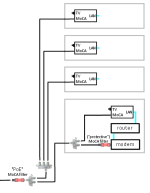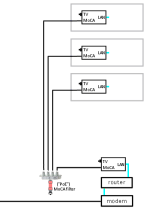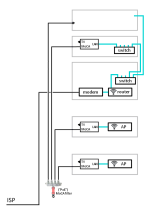Brett Stimpson
Occasional Visitor
I have the following equipment:
comcast cable- no tv service
Arris Modem SB6141
Google wifi mesh
3 Actiontec moca 2.5 adapters
My set up which is working.
cable in from comcast with POE filter to Ideal #85-132 5Mhz-1Ghz spliter (2)4db out
1- out to office/ then 2 way splitter/ one end going to arris modem other end going to moca adapter/ google wifi router puck/ 4 port switch.
2- out to another spliter/ one end going to basement moca adapter/ google wifi puck and the other end going to family room moca adapter /google wifi puck
its working, but is it correct? I tried to buy this: https://www.amazon.com/dp/B08QF5SHHC/?tag=snbforums-20
but it made two pucks turn red and not work.
Which switch would allow me to connect all my cables together? this way the house would be outfitted for moca in other rooms not currently used.
i have a box next to the fuse panel where they terminated all the coax lines together. They were originally hooked to this , what i think is a power amplifier for UHF signals for over the air tv? The previous owner does have a large antena in the attic. He also had satelite but im only using internet with roku.
comcast cable- no tv service
Arris Modem SB6141
Google wifi mesh
3 Actiontec moca 2.5 adapters
My set up which is working.
cable in from comcast with POE filter to Ideal #85-132 5Mhz-1Ghz spliter (2)4db out
1- out to office/ then 2 way splitter/ one end going to arris modem other end going to moca adapter/ google wifi router puck/ 4 port switch.
2- out to another spliter/ one end going to basement moca adapter/ google wifi puck and the other end going to family room moca adapter /google wifi puck
its working, but is it correct? I tried to buy this: https://www.amazon.com/dp/B08QF5SHHC/?tag=snbforums-20
but it made two pucks turn red and not work.
Which switch would allow me to connect all my cables together? this way the house would be outfitted for moca in other rooms not currently used.
i have a box next to the fuse panel where they terminated all the coax lines together. They were originally hooked to this , what i think is a power amplifier for UHF signals for over the air tv? The previous owner does have a large antena in the attic. He also had satelite but im only using internet with roku.




